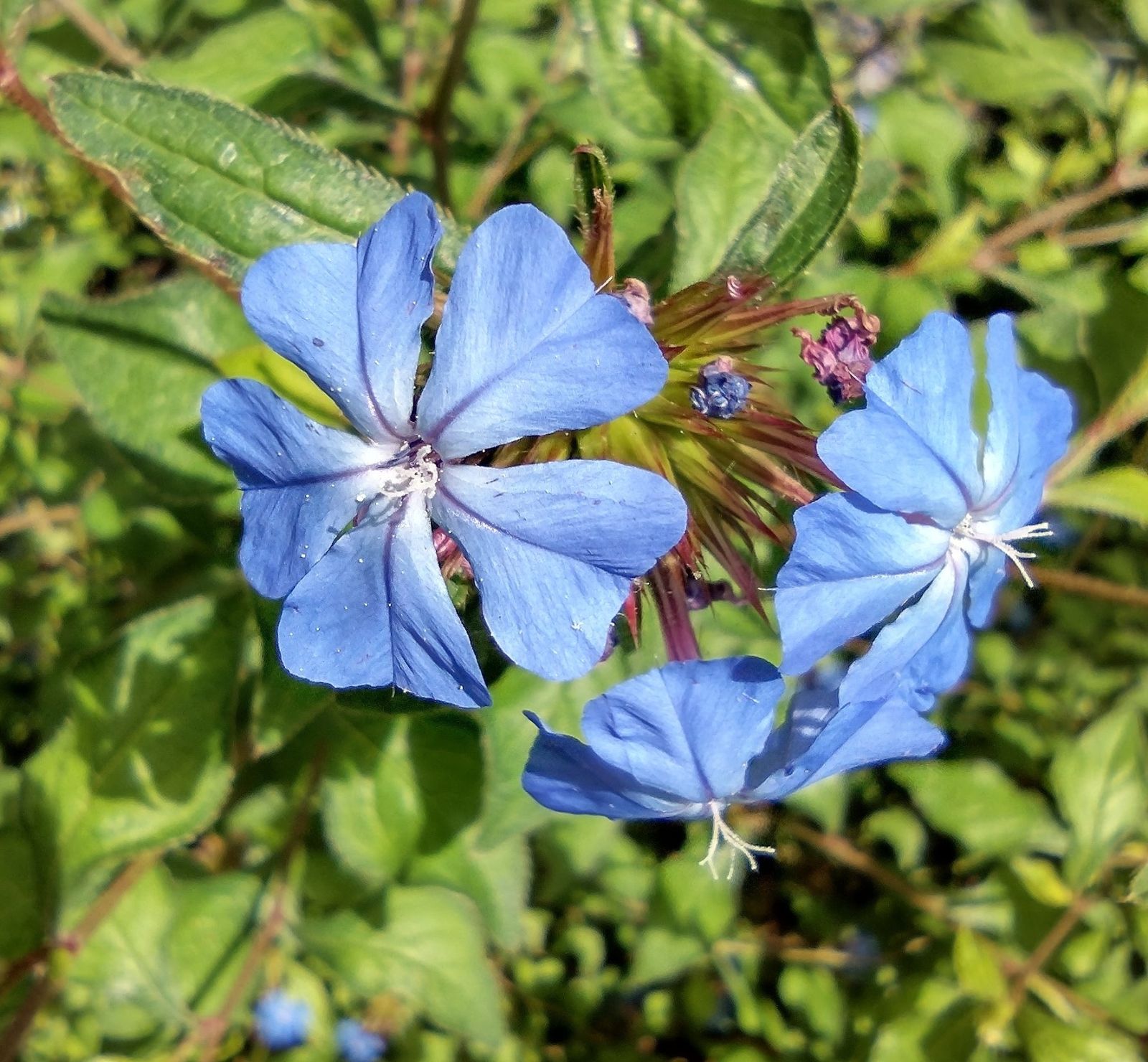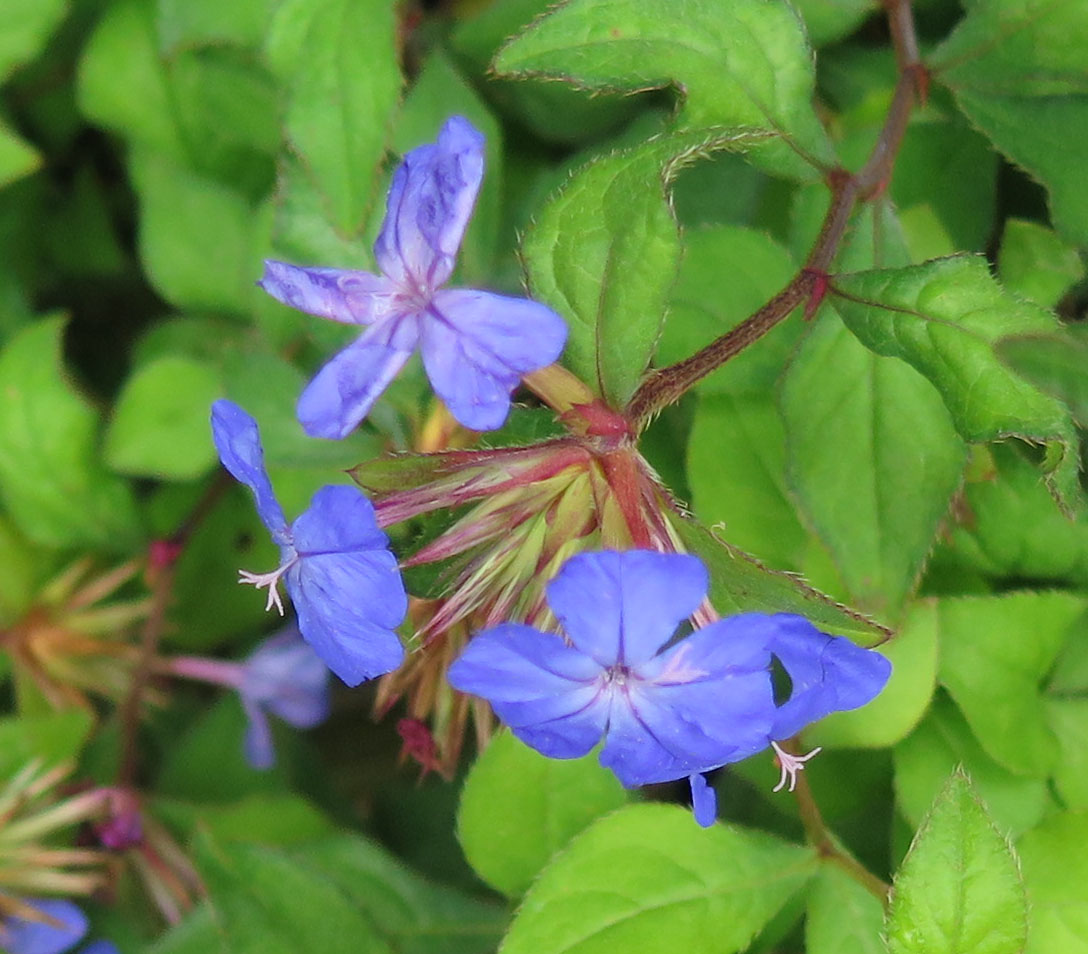Ceratostigma willmottianum
Sponsor
Kindly sponsored by
a member of the International Dendrology Society
Credits
Julian Sutton (2021)
Recommended citation
Sutton, J. (2021), 'Ceratostigma willmottianum' from the website Trees and Shrubs Online (treesandshrubsonline.
Genus
Infraspecifics
Slender, deciduous, somewhat rhizomatous subshrub, to 2 m in the wild, rarely more than 1 m in cultivation. Branches fragile, pith equalling or wider than the surrounding xylem; nodes with a ring-like scar where the clasping petiole has fallen. Branchlets with short, sparse, adpressed hairs. Bud scales present. Petiole base clasping the stem. Lower leaf blades more or less diamond shaped, 2–5 × 1.2–1.8 cm, those below the inflorescence usually lanceolate; both surfaces with bristly hairs, sparse above, dense beneath; margins with bristles; base cuneate and attenuate, apex usually acute. Inflorescences terminal or axillary, with 3–7 flowers, sometimes crowded; bracts ovate-oblong to oblong, 6–8 × 2–3.5 mm, apex acute; bracteoles ovate or oblong, 5–7 × ~3 mm. Calyx 10–15 × ~1 mm, with short, sparse adpressed hairs, lobes ~4 mm. Corolla 2–2.6 cm, tube red-purple; lobes blue, obdeltate, 9–11 × ~7 mm, apex notched and mucronate. Heterostylous. Summer–autumn flowering, June–October in the wild. (Peng & Kamelin 1996; Stapf 1914; Gao et al. 2021; Cullen et al. 2011; Edwards & Marshall 2019)
Distribution China Gansu (Wen Xian), W Guizhou, S and W Sichuan, SE Xizang, E and N Yunnan
Habitat Forest edges and thickets, in warm valleys, 700–3500 m
USDA Hardiness Zone 6-9
RHS Hardiness Rating H4
Awards AGM
Conservation status Not evaluated (NE)
A garden classic in all but the coldest parts of our area, C. willmottianum is grown for its copious bright blue flowers in rather dense heads, opening successively for three or four months in summer and autumn. The leaves often develop attractive red tints towards the end of the flowering season. Subshrubby in nature, it dies back more decisively in cold areas, behaving in effect as a herbaceous perennial, and even when aerial shoots survive many gardeners encourage vigorous new growth by cutting it back to near ground level in spring. Annual growth approaching 1 m in height is possible with a warm growing season and adequate moisture, but in gardens it rarely approaches the 2 m recorded in the wild. A sunny position is ideal; poor, dry or chalky soils are tolerated (Bean 1976). Beyond our area, it makes an excellent garden plant even in East Africa, where it grows best in light shade (Cameron 2017).
C. willmottianum belongs to a trio of rather similar western Chinese species, with C. griffithii and C. minus. C. griffithii has a more westerly range in Bhutan and southern Xizang, usually smaller, obovate leaves (closer to diamond-shaped in willmottianum), with denser hairs on stems and both leaf surfaces. It is also more shrubby than C. willmottianum, although it too will grow back freely from the base and flower when cut back annually (Havlis 2021). At least in the usual garden form, C. willmottianum is less branched, with most flowers in terminal inflorescences. C. minus is less clearly differentiated; while the older literature distinguishes it from the other two by the combination of shrubby habit and a more or less glabrous upper leaf surface, Flora of China (Peng & Kamelin 1996) allows hairier forms in its circumscription and there is ongoing uncertainty about the identification of at least one collection (see discussion under C. minus).
C. willmottianum was well established in Western cultivation by the time it was described. It was first collected as seed for the Arnold Arboretum by Ernest Wilson, in the semiarid Min River valley, W Sichuan (W. 1373 & 2314 of 1908; Wilson in Sargent 1916). Two seedlings were raised by Ellen Willmott at Warley Place, Essex, UK from seed sent by the Arnold (presumably a share of the original gathering), and from these the species was described (Stapf 1914). The specific epithet commemorates Miss Willmott, whose once fabulous garden is now a delightful ruin.
Fast-growing and easily propagated by semi-ripe cuttings in summer, it seems likely that Wilson’s introductions dominate cultivated stock, perhaps even as a single clone in Europe. Later introductions from Sichuan attributed to C. willmottianum include H&M 2103 (grown at Quarryhill Botanical Garden, California). SICH 59 of 1988, grown at RBG Edinburgh, Howick Hall, and Quarryhill has been variously interpreted as C. willmottianum and C. minus (Royal Botanic Garden Edinburgh 2021; Quarryhill Botanical Garden 2021) but as seen on the Edinburgh rock garden is lower and more dense than typical C. willmottianum of British gardens (J. Grimshaw pers. comm. 2021).
This is a heterostylous species, with long- and short-styled morphs, coupled with a degree of self-incompatibility (Gao et al. 2021). Long-styled plants seem to be the norm in British cultivation (pers. obs.), perhaps reinforcing the suggestion of a single dominant clone, but further investigation is required. In a Min River valley population, Gao et al. (2021) found that the corolla limb (and hence the ‘face’ of the flower) was on average larger in short-styled plants, something to be considered by plant breeders. Single clones seem to set little seed: at the start of his breeding programme – see cultivars below, Peter Catt (pers. comm. 2021) sowed ‘5 or 6 boxes’ of uncleaned seed heads, raising just 5 seedlings, but intercrossing these yielded far more seed.
'Lice'
Synonyms / alternative names
Ceratostigma willmottianum FOREST BLUE
Awards
AGM
More compact and branching, very floriferous (Edwards & Marshall 2019); a long-styled clone. Selected by nurseryman Peter Catt, Hampshire, UK in the early 1990s. Five seedlings were raised from a conventional cultivated stock of C. willmottianum in a fruitless attempt to raise a white or pink flowered plant. While open-pollinated, no other species were present and this probably represented self pollination of a single clone. These plants were grown closely together, and a second generation of open-pollinated seedlings raised from them: this was one, the others appearing normal. At the time, large producers were spraying C. willmottianum for the garden centre trade with growth retardants, giving a plant which presented better on the bench. Beyond its real garden value, this cultivar made that practice unneccessary (P. Catt pers. comm. 2021). European plant breeder’s rights apply.
'Lissbrill'
Synonyms / alternative names
Ceratostigma willmottianum SAPPHIRE RING
Yellow-leaved, but with a stronger constitution and more branching habit than ‘Palmgold’. Bred by Peter Catt about 1990, by growing ‘Lice’ and ‘Palmgold’ together, and raising seedlings from ‘Lice’: three had yellow leaves, of which this is one (P. Catt pers. comm. 2021). All the yellow-leaved cultivars flower less freely (P. Catt pers. comm. 2021). Marketed in Europe; European plant breeder’s rights apply.
'My Love'
A sister seedling to ‘Lissbrill’ with similar attributes, marketed in North America (Justia Patents 2007; P. Catt pers. comm. 2021). PP 19,269 granted 2008.
'Palmgold'
Synonyms / alternative names
Ceratostigma willmottianum DESERT SKIES
Bright yellow leaves but a weak grower (Edwards & Marshall 2019). A sport on conventional C. willmottianum in commercial production at Palmstead Nurseries, Kent, UK before 1999 (P. Catt pers. comm. 2021). European plant breeder’s rights apply.


